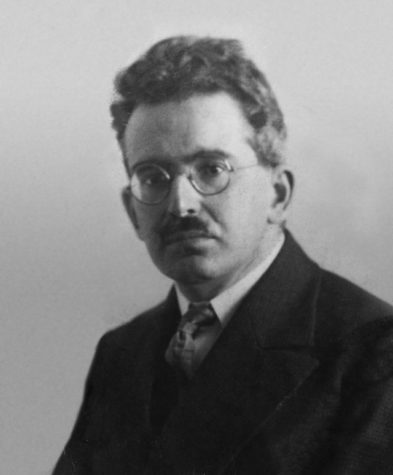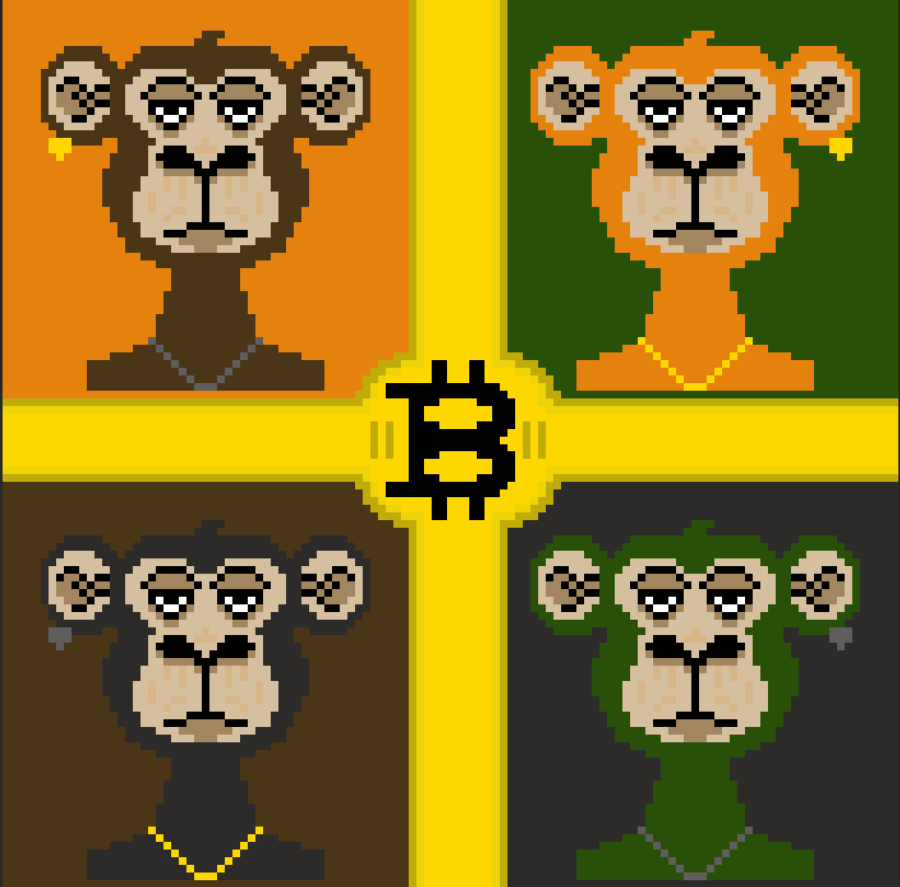NFTs in the Age of Digital Reproduction
The past year saw the explosive growth of the Non-Fungible Tokens. With their popularity skyrocketing, what impact will they have upon the world of digital art?
Here is a mashup between Andy Warhol’s signature style of pop art and some common themes among NFTs, with a bitcoin anchoring the whole piece.
A leopard print ape, with one diamond stud earring, obnoxious 3D glasses, a grimy undershirt, and a careless expression. A blue skinned man in 64 bit, with a white face mask, a beanie colored in the intersection of orange and red, a single gold spherical earring, and eyes that resemble dice. A quick Google search for NFT (Non-Fungible Token) turns up some of these images. Though they can be saved on your computer in three clicks, they are sold online for millions.
Introducing NFTs
The origin of these tokens can be traced back to an idea known as the colored coin. Among cryptocurrency aficionados, the colored coin was a virtual token that represented ownership over any asset, whether that is a yacht or a digital media file.
To validate this, the token utilized a technology that will continue to redefine our understanding of property rights. This technology is known as a blockchain, a database that is used to store details concerning a party’s ownership over an item.
One can think about it as an impenetrable digital lockbox containing a deed granting rights over virtually anything. The blockchain ensures the data that it holds cannot be altered, generating trust without the need of a third party.
Soon after, such technology was used by entrepreneurs to represent anything from cards in online games to variations on internet memes. But what would truly birth our modern conception of the NFT would be the efforts of two Canadian software designers and their firm LarvaLabs.
In 2017, they released 10,000 images of what are known as the CryptoPunks that could be claimed for free if one possessed a wallet for the cryptocurrency Ethereum. Each image depicted similar pixel art style characters with appearance attributes like skin color, hair, and accessories generated by a computer algorithm.
CryptoPunks would rapidly rise in popularity due to their limited quantities and their exciting intersection with what many views as the currency of the future. Today, they make up some of the most expensive NFTs sold on the market with CryptoPunk #5822 selling for upwards of $23 million.
This project would set the standard for current trends in NFTs, from the minting of the tokens on Ethereum compatible blockchains to creating a varied set of characters through random generation.

To demonstrate the process that one might take to enter the world of NFTs, I tried to create and mint my own. The journey began in PhotoShop, twenty minutes passed by, and what was soon to be known as ‘Frug’ was born.
In a matter of seconds, I set up an Ethereum wallet and connected it to one of the largest NFT marketplaces, OpenSea. Clicking a couple more times through the website, I named the image that I created, added the description ‘Frugguy,’ picked a blockchain through a drop-down menu, chose a price, and published it. The final product is available to view HERE.
Tracing the Hype
When we imagine expensive art, we think of millionaires at an auction house bidding on a Gauguin, Picasso, or a Mondrian. The NFT market is quite similar, simply replacing those painters with CryptoKitties, Beeple, and Bored Ape Yacht Club — some of the most popular NFT artists and firms.
Yet, while a Warhol is a physical piece that can be owned by a lucky consumer, NFTs are mostly intangible digital media files ranging from gifs to videos. As mentioned before, the ownership data is recorded on a blockchain, but the actual art is hosted on a separate server which the owner can access via a hyperlink stored in the blockchain.
In trying to understand some of the factors that drive the demand for such digital media, I located the online communities where NFT enthusiasts gather. A common theme that I observed was the tendency for many aspiring NFT tycoons to promote their projects in these locales.
One concept that was very noticeable in all the ways that they decided to market themselves. They all wanted their product to denote something special for their consumers, utilizing words like ‘unique’ and ‘exclusive’ in order to convey both scarcity and originality.
There is a bit of a problem in this whole arrangement, one that concerns the physical differences between a painting and a digital file. It is very easy to download or screenshot the artwork represented by the NFT, so the originality that is implied by the term non-fungible comes under scrutiny.
I contacted Professor W. J. T. Mitchell who specializes in art history and theory at the University of Chicago to make sense of this problem. “The non-fungibility part seems like an advertising ploy, because it makes you think you have something precious beyond price,” said Mitchell.
NFTs and Aura
Our cultish dedication to the original is most intensely realized in the NFT. In an age where digital art can be replicated and distributed in an instant, originality is worth millions of dollars.
For the philosopher Walter Benjamin, this phenomena conflicts with the potential technology has to make art accessible. Benjamin is one of the prime theorists of Germany’s Frankfurt School which focused on Marxist social criticism and critical theory.
In his well-known 1936 essay “The Work of Art in the Age of Mechanical Reproduction”, he argues that our new capacity to reproduce art rapidly liberates it from its aura. Aura can be associated with our religious devotion to authenticity, which makes art impenetrable, an almost supernatural aspect.

In regards to the relationship between NFTs and aura, Professor Mitchell was skeptical. “Benjamin’s point is that these things are not fungible, they’re not copy-able, so it has aura for that reason, but I think Benjamin if he read about this would be rolling in his grave. The NFT seems to be saying that it somehow goes back to the earliest moment of art, where every artwork was singular, there was no such thing as a copy, it’s one of a kind, but that’s a delusion.”
In making his argument, Benjamin constructs a genealogy of art, emphasizing that early art did not have much opportunity to be reproduced and thus its originality is reliant on its unique place in time and space. Reproduction interferes with this because it can divorce the artwork from this unique place.
For example, the art can be placed in contexts that do not agree with the original context. One can take a picture of the Mona Lisa, edit it to their liking, and most importantly exhibit it beyond its intended space.
The ability for art to be reproduced allows society en masse to interact with it. Art does not have to be secluded contemplation, an act of worship, or a feedback loop of high society pretentiousness.
Later philosophers like Jean Baudrillard lament this loss of aura. Baudrillard’s interests lie in a critique of contemporary society from the standpoint that global developments are causing a loss of meaning. For him, the proliferation of art into every aspect of our lives renders it meaningless, no longer tending to be life-altering.
Aura is facilitated by a distance that we feel from the art. Its supernatural force is exerted on us, opening our eyes to realities beyond the limits of our imagination or truths we have yet to grasp.
While aura commands exclusion and destructive obsession, it also has the power to subvert our contemporary lives.
In my conversation with Professor Mitchell, I observed a similar sentiment concerning the purpose of art. “I think for artists, and I know a lot of artists, most of them are thinking about what an interesting work of art is. What can I make that somehow says something interesting or creates something beautiful, something at the highest level, astounding and complex? Art is showing people the world truly or showing an alternate world that hasn’t been thought of yet.”
Concluding Aura, NFTs, and the Market
A good majority of NFT projects follow the CryptoPunks model, with one of the most notorious offenders being the Bored Ape Yacht Club. Every celebrity from Jimmy Fallon to Paris Hilton owns one and proudly displays the face of a worn-out ape on their social media.
One of their marketing strategies involves the inclusion of these figures to facilitate a private social club for members that provide them with prestige and exclusive opportunities.
Another NFT project called Vekings creates a story around its project and urges its consumers to work towards a resolution in that story by investing in their work. These are just a couple of the ways that these firms try to get people to buy into the simulated aura of their product which is in constant jeopardy from reproduction.

( CC0 1.0 Universal (CC0 1.0) Public Domain Dedication)
“Mechanical reproduction destroys the aura that the collector of the unique object desires to possess, and that survived certainly in the myth of the NFT. It’s an appeal to somebody who regards art as an investment of money,” said Mitchell.
Beyond these projects, some artists benefit from how they can monetize their work through this new medium and respective collectors who attain enjoyment beyond price in their acquisition of these pieces.
Mitchell put it best, saying, “It makes me feel good the way I have artworks in my house. I don’t look at them every day, but when I do, I generally say yes, I know who made that, and I know the story that goes with it. I care about it, it’s not for sale, and I would never try to cash it.”
Generally, I would say that this relationship still privileges that aspect of aura which preserves the piece’s unique position in time and space. This is an attempt to privatize a work and seclude it in a medium that is constantly threatened by digital reproduction.
As Benjamin noted, reproduction of art can emancipate it in such a way that everybody can conduct and absorb the subversive messages of art. Going against Baudrillard, Mitchell follows Benjamin, saying, “Reproduction itself is not the enemy. For one thing, reproduction in the invention of photography democratized the representation of reality.”
What Benjamin and Baudrillard do agree upon is that the copy degrades and diminishes the aura. In responding to this, Mitchell pointed me towards a parallel essay that he wrote in the early 2000s on the work of art in the age of biocybernetics.
“Cloning was the idea of making exact reproductions of living things, living copies of living things. That was a strange inversion of Walter Benjamin’s point about copies. For Benjamin, and this is true for Baudrillard as well, the copy is always kind of a dead-end version of the original. It has lost the life that was there. That’s what aura means, it’s the breath. So what happens with the figure of the clone? Well, I said it’s got just as much aura as the original; it’s a copy, it has the same DNA,” said Mitchell.
Our digital landscape grants us the ability to clone to a greater degree than was possible in Benjamin’s day. This can be utilized to undermine the relationship between NFTs, aura, and the market. Artwork must aspire both to the values of widespread access as championed by Benjamin and a commitment to the subversive through Baudrillard.
One of three things is foreseeable in the future of NFTs. As the idea of the metaverse becomes more prominent, we might stop consuming commodities for our physical selves and instead consume them for our virtual selves. NFTs may become the new model through which we monetize authenticity and recognition and pursue these values through mass consumption.
There might also be the idea that they don’t have much of an impact at all; they could just be a fad. It is possible that they will have a stable presence but won’t interfere with our practice of consuming physical goods.
The most optimistic of these options is the idea that the problems that NFTs pose can be useful to promote the mass democratization of art. Breaking away from the NFT model means revolting against the market as much as it means that art can be a community-based initiative that realizes truths that cannot be pursued alone.
“Mechanical reproduction destroys the aura that the collector of the unique object desires to possess, and that survived certainly in the myth of the NFT. It’s an appeal to somebody who regards art as an investment of money,” said Professor W.J.T. Mitchell.
Rahib Taher is a Copy Chief for 'The Science Survey.' He enjoys journalistic writing as it gives him the liberty to write about topics that interest him....











